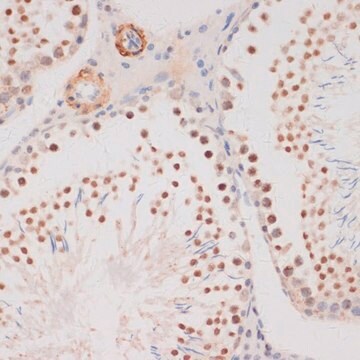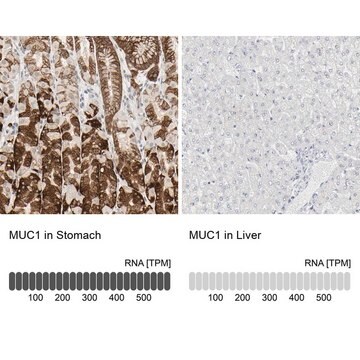SAB4200781
Anti-Haptoglobin antibody, Mouse monoclonal
clone HG-36, purified from hybridoma cell culture
Synonym(s):
Anti-HP, Anti-Zonulin
About This Item
Recommended Products
biological source
mouse
Quality Level
antibody form
purified from hybridoma cell culture
antibody product type
primary antibodies
clone
HG-36, monoclonal
form
buffered aqueous solution
species reactivity
human
packaging
antibody small pack of 25 μL
concentration
~1.0 mg/mL
technique(s)
ELISA: 0.2-0.4 μg/mL using 10 μg/ml human haptoglobin for coating
dot blot: suitable
immunoblotting: suitable
immunoprecipitation (IP): suitable
isotype
IgG1
UniProt accession no.
shipped in
dry ice
storage temp.
−20°C
target post-translational modification
unmodified
Gene Information
human ... HP(3240)
General description
Monoclonal Anti-Haptoglobin specifically recognizes the three types of human haptoglobin (types 1-1, 2-1, and 2-2) The antibody recognizes both purified and haptoglobin in human serum, and shows no crossreactivity with human IgG, transferrin, C-reactive protein, α-1-acid glycoprotein, albumin, hemoglobin, or bovine, goat and sheep serum haptoglobin.
Immunogen
Application
Physical form
Other Notes
Not finding the right product?
Try our Product Selector Tool.
Storage Class Code
12 - Non Combustible Liquids
WGK
WGK 1
Flash Point(F)
Not applicable
Flash Point(C)
Not applicable
Regulatory Listings
Regulatory Listings are mainly provided for chemical products. Only limited information can be provided here for non-chemical products. No entry means none of the components are listed. It is the user’s obligation to ensure the safe and legal use of the product.
JAN Code
SAB4200781-25UL:
SAB4200781-100UL:
SAB4200781-BULK:
SAB4200781-VAR:
Choose from one of the most recent versions:
Certificates of Analysis (COA)
Don't see the Right Version?
If you require a particular version, you can look up a specific certificate by the Lot or Batch number.
Already Own This Product?
Find documentation for the products that you have recently purchased in the Document Library.
Global Trade Item Number
| SKU | GTIN |
|---|---|
| SAB4200781-25UL | |
| SAB4200781-100UL | 4061833265352 |
Our team of scientists has experience in all areas of research including Life Science, Material Science, Chemical Synthesis, Chromatography, Analytical and many others.
Contact Technical Service








